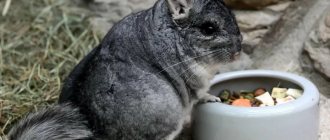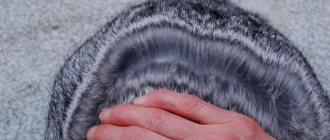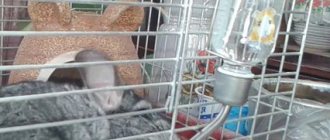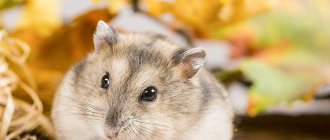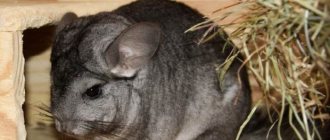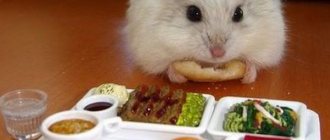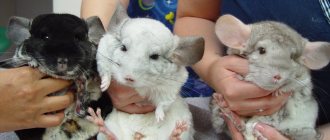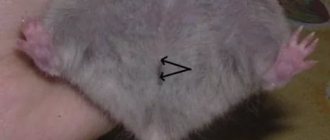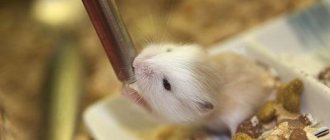The chinchilla is a small herbivorous rodent with thick and soft fur. It is not difficult to have such an animal as a pet. It is unpretentious in food and maintenance, and its life expectancy in captivity is on average 10-12 years. Exotic rodents can bring their owner not only positive emotions, but also a good income.
The value of chinchillas is due to their very thick and dense hair. The fur is so thick that it doesn’t even harbor parasites. Chinchillas do not shed, and their fur does not cause allergies. Therefore, its cost is much more expensive than the cost of arctic fox, mink or sable fur. The demand for items made from chinchilla fur is growing, while materials often have to be imported from abroad. Competition in the market of the Russian Federation and CIS countries is low, which significantly increases the chances of a successful business in raising and breeding these animals.
You can breed chinchillas at home for sale. Many people love these cute furry animals, but buying them at the bird market is dangerous. The cost of one individual fluctuates in a fairly wide range - from 1,000 rubles. up to 40,000 rubles, and sometimes higher. It all depends on the color, quality of fur, size or gender.
The most important thing about such a business idea is that there is no need to rent premises or hire workers. You can set up a mini-farm for growing chinchillas right at home.
Where to start breeding chinchillas as a business at home
In addition to the fact that you need to acquire at least a couple of individuals, you have to complete the following activities:
- Develop a business plan for raising chinchillas at home.
- Prepare a room intended for the farm.
- Purchase the necessary equipment: food, sawdust, cages, toys.
- Place animals on the farm and provide them with a comfortable stay.
- Think over legal ways to receive income from the sale of products: register a business, determine the appropriate tax regime, understand the reporting.
IMPORTANT
: For the cultivation and sale of this type of product, permission from regulatory authorities and licenses are not required.
You need to understand how to breed chinchillas at home. In 1 year, the female produces up to three litters. One litter can have 1-3 cubs. With relatively small capital investments, starting a business requires a large time investment. However, the return on investment is high.
Financial plan
The business plan should include the following expense items (in rubles):
- purchase of animals – 150,000;
- purchase of equipment – 150,000;
- advertising – 10,000;
- other expenses – 30,000;
- premises (it is better to rent a separate one, since animals are noisy and keeping them in their own apartment is not always the best option) – 50,000.
Look at the same topic: Organizing a business with China: how and where to start?
Total: 390 thousand rubles.
Payback period – from 2 years.
Selection and preparation of premises
Despite the fact that chinchillas are extremely unpretentious, you should approach the choice of premises responsibly. A number of conditions must be met:
- One individual needs about 0.3 m2 of area;
- permissible room temperature – 18-20 degrees;
- air humidity should not exceed 60%;
- it is important to make sure there are no drafts;
- the room must be clean;
- there should be little light, rodents do not like bright rays;
- The level of noise and harsh sounds should be minimal.
Take care of regular cleaning and ventilation. The appearance of mold or mildew in the room is unacceptable. The best solution would be to fence off the chinchilla farm from other buildings. Remember, animals are very shy, especially during the mating period.
Breeding chinchilla rabbits
Recently, farming as a business idea for beginners has attracted the attention of many citizens of our country. If your financial capabilities do not allow you to organize a chinchilla farm, try breeding chinchilla rabbits. These are universal animals from which you can get not only fur, but also tasty dietary meat. Among the representatives of this breed you can find varieties weighing 2.5-3 kg and real giants, whose body weight reaches 6-7 kg.
The most common breeds of chinchilla rabbits are:
- Soviet;
- American;
- Gigantic;
- Regular.
In order to organize the breeding of decorative rabbits as a business, you will not need large investments. They are unpretentious to the conditions of detention and are characterized by increased survivability. Another profitable idea is cat breeding as a business. This type of activity is suitable for people who keep cats at home and consider them members of their family.
Purchase of cages and equipment
Having prepared the room, proceed to purchasing a cage and related equipment. Avoid any wooden parts - rodents will quickly make short work of them. It is forbidden to paint the room, as animals cannot tolerate the smell of chemicals very well.
The optimal cage size can be considered 50/50/60 cm. You can purchase a larger enclosure - it all depends on how many individuals you plan to have. The main condition is about 30 cm2 per individual. Males and females can be housed in pairs or separately, it all depends on the method of reproduction and the nature of the pets. Chinchillas are very agile rodents, so the cage should have small cells so that they cannot get out of it. When choosing a cage, pay attention to its safety and ease of cleaning. Experienced breeders place 6 cells in 2 rows. With this arrangement, the required area will be about 18 m2.
You will need:
- Sippy cup. It is best to choose hanging drinking bowls with automatic water supply.
- Hopper type feeder.
- Bath for bathing with sand. It should be spacious enough with closed sides.
- Bed or house.
- A house for a female during childbirth.
- Tray at the bottom of the cage.
- Toys - running wheel, tunnels, balls.
- Trainers for teeth. These can be mineral stones or pumice.
Remember that pets need to jump and move a lot, so make sure that the house has various shelves and perches. The distances should not be large so that the animal does not damage its paw when landing.
Features of choosing and purchasing breeding stock
Once you have prepared the room and cage, it is time to start purchasing livestock. For a home mini-farm, it is enough to purchase 2 males and 10 females. Such a set can produce 70-80 young animals in 1 year.
Many breeders and farms provide temporary males for mating - consider these options.
There is an opinion that chinchillas should be bred monogamously, i.e. form pairs and let them breed separately. This method has a number of advantages, but is more expensive.
Buy young animals only from large and trusted breeders. This way you will protect yourself from buying a sick animal. In addition, breeders can provide a guarantee and a breeding card.
Chinchilla breeding
The female is ready for reproduction at the age of 4-7 months, the male at 7-9 months. In breeding conditions, one female can bear offspring without harm to health for 8 years. An older female will also produce offspring, but the cubs will be weaker and sicker.
Mating usually occurs at night. If fertilization has occurred, you will find tufts of fur and small waxy flagellum in the cell. Next, the female will gain approximately 100g. every two weeks. A pregnant female should be given more vitamins. The gestation period is 104-115 days. A couple of weeks before giving birth, the female needs to equip a room with sawdust and block the road to the bathing bowl. Monitor the behavior of the male; if he interferes, he should be isolated.
Childbirth usually takes place in the morning and no human intervention is required. When breeding polygamously, the male should be isolated from the female and the young for a couple of weeks. With the monogamous method, the male can be left in the cage. However, remember that immediately after giving birth, the male will try to cover the female again. One female can become pregnant up to 3 times a year, so make sure that her health is not compromised.
Young animals weigh from 30 to 70 g. Newborn babies are able to move independently. Milk feeding lasts up to 60 days, after which the young animals can be weaned from their mother. If the female does not have milk, the babies are transferred to one who has recently whelped, or are transferred to artificial feeding.
Care and maintenance of chinchillas at home
The chinchilla is unpretentious and does not require careful care. It is enough to clean the cage daily and ensure the availability of fresh water and food. The bedding in the cage should be changed once a week. Once every six months it is worth checking the cage for integrity and disinfecting it. Wet cleaning of the premises is recommended once a month.
You can buy food in specialized stores or prepare it yourself by mixing different types of grains. In addition to cereals, chinchillas love hay and dry dandelion leaves. In summer, you can add fresh grass to your diet. In winter, animals are given carrots and apple pieces. Feeding occurs once a day in the evenings. For 1 animal there is up to 50g. stern. If there is a lack of sunlight, add liquid vitamin D to the food.
Nutrition
The main food consists of specialized granulated food, hay and water. In this case, the food should be produced only for chinchillas. It cannot be replaced with food for rabbits, hamsters or other rodents.
It is cheaper to buy feed from farms, since highly specialized retail outlets add substances that allow the product to be stored for a long time, but it does not bring any benefit to the animal. Remember, the best food source is clean pellets. Do not buy food in the form of rings, seeds, cereal grains, etc.
The water must be filtered; it is not recommended to use boiled water. Hay should be green, fresh and clean. Do not use hay for bedding as it will become contaminated. If the animal eats it, it will lead to poor digestion or bloating.
Sale of chinchillas, markets for products
The best option for home farms is the sale of live animals. Your clients can be individuals, stores or wholesale buyers.
Sales can be divided into the following categories:
- Realization of marriage. Culled chinchillas are a common occurrence on chinchilla farms. We are not talking about weak and sick animals. Rejects are those individuals that are not suitable for reproduction, or those whose fur turns out to be of poor quality. Clients in this case can be bird markets, pet stores or individuals who want to get an exotic pet. The cost of sales will depend on the average prices in your region. As a rule, it is low - from 2,000 to 5,000 rubles. for one animal.
- Sales of breeding animals. It is possible to raise chinchillas intended for breeding. In this case, the clients will be beginning breeders or farms that require breeding material. The cost of implementation here is much higher. It all depends on the breed, age, gender, external parameters.
- Fur sales. This type of implementation is preferable for large farms with a population of 300 males or more. It is the fur of male chinchillas that is considered to be of higher quality and is used in the production of various products. Clients are large fur studios in big cities. Cost – from 7,000 rubles.
- The most profitable market for chinchilla fur is auctions. The cost of one skin when traded under a hammer can reach tens of thousands of rubles. However, to get into this niche, as a rule, a home chinchilla farm is not enough. Larger production volumes and animals of rare and valuable breeds are required.
Possible risks
When planning this type of business, be sure to consider all possible risks. The biggest danger is the loss of animals. The disease of the entire livestock can lead to very unpleasant consequences. Despite the fact that chinchillas are not susceptible to diseases, they require careful care. When purchasing a new individual, monitor its behavior for a couple of days. Poor nutrition can lead to illness. Under no circumstances should you wash animals with water - this will make their fur worse.
Considering competition as a risk for doing business does not yet make much sense. Chinchilla breeding has not yet become widespread and this niche remains relatively free. However, it is still worth monitoring the state of the market in your region; perhaps there is a large breeder and seller of these animals very close by. Don't be afraid of competition, observe and learn from positive experiences.
Business relevance
It's no secret that chinchillas are one of the most expensive and sought-after fur products in the world of the fashion industry. But this is not all the advantages of a fur-bearing animal. Its meat is dietary and is used for medicinal purposes. It is recommended for tuberculosis and indispensable for sclerosis. Scientists have also been able to prove that this meat makes it possible to treat cancer.
Few people know that chinchillas are unique animals. They live in places where gold and precious stones are placed nearby. Since ancient times, treasure hunters around the world have used these animals to find treasures.
Today, treasure hunters have changed their status to entrepreneurs and receive excellent income from breeding these animals. Let's consider the features and pitfalls of this business.
